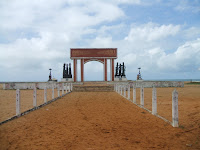For an amazing vacation full of history, adventure, and dream-like beaches visit Benin the country squished between Nigeria and Togo on the Guniea Coast. When visiting there are four must stops: Pendjari National Park, Abomey, Oudiah, and Cotonou.
Pendjari National Park.
In the northwestern corner of Benin inside the Pendjari river loop over 1200 acres of thinly wooded savanna houses a vast array of birds, reptiles, and mammals from elephants to lions. Well planned observation decks overlooks hippopotamus, reptiles, and birds along the river. The park shares land with Burkina Faso and Niger making it one of the largest wildlife reserves in West Africa. The diverse eco-system allows the park to support life for a wide variety of species, several subspecies of animals found in East African reserves. Enhance your safari by staying at the le Campement de la Pendjari an oasis in the heart of Pendjari.
 On the way out of Pendjari stop by the Taneka waterfalls. With the help of a local tour guide take a short hike up into a picturesque valley perfect for sun bathing, lunch, or a cool dip.
On the way out of Pendjari stop by the Taneka waterfalls. With the help of a local tour guide take a short hike up into a picturesque valley perfect for sun bathing, lunch, or a cool dip.Before you leave the north visit a Tata Somba - a mud fortress - designed to protect families and livestock from invaders such as slavers.
Abomey.
For over two hundred years the Kings of Dahomey ruled their kingdom from Abomey, but it was during the 17th century that they reached the height of their power because of their role in the West African Slave Trade. African slavers would capture villagers, from as far away as present day Tanguieta, and bring them to the King in Abomey, who would then trade them to the Europeans. Afterward, slaves were forced to march over 50 miles to reach the ships that awaited them at the coastal ports in Ouidah and Grand Popo. When the kingdom fell to the French in 1892, the French built a new capital just to the east of Abomey called Bohicon. Today the palace and its ground are the Abomey Historical Museum (www.epa-prema.net/abomeyGB). Through a combination of photos and artifacts visitors tour the over 108 acres and learn about the rise and fall of the Dahomey Kingdom and life under early French colonization. At the end of the tour guests can find an array of memorabilia available from local artists.
Ouidah, a town of contradictions.
 The only safe harbor landing on the coast Ouidah served as the dominate port for over 300 years home to French, Portuguese, Danish, and XXX Forts. During the 17th Century, Ouidah was a slaves final destination before heading to the new world. Today the process has been memorialized in the local museum and two-mile hike. The Musee d’Historire d’ Ouida - originally the Portuguese Fort- is the official Museum for history on the slave trade in Ouidah. After the museum take the comfortable two-mile walking tour of The Slave Route - an emotionally charged and physically brutal trail that slaves were forced to endure before boarding ships to the New World.
The only safe harbor landing on the coast Ouidah served as the dominate port for over 300 years home to French, Portuguese, Danish, and XXX Forts. During the 17th Century, Ouidah was a slaves final destination before heading to the new world. Today the process has been memorialized in the local museum and two-mile hike. The Musee d’Historire d’ Ouida - originally the Portuguese Fort- is the official Museum for history on the slave trade in Ouidah. After the museum take the comfortable two-mile walking tour of The Slave Route - an emotionally charged and physically brutal trail that slaves were forced to endure before boarding ships to the New World.While Ouidah is home to pain, it is also home to the mystical - voodoo. An integral part of Beninese culture voodoo is practiced in various forms throughout the country less as a religion and more a fact of life. Unlike other areas though voodoo is highly visible with ceremonies performed in the streets and fetishes in front of homes. At the center of town the Musee de Voodoo is a run down, rarely visited building, but what it lacks in polish, the guide makes up for in knowledge.
At the end of the day relax and reflect at one of the European-style hotels on the quiet beaches and imagine another time when large wooden ships filled the waters carrying slaves and slavers to a New World.
Cotonou.
 In 1908, the French built the present port in Cotonou effectively muting Ouidah’s importance. Over the years it has grown to a huge metropoliswith all the amenities - a shopping mall, four-star hotels, art galleries, artisan market, cultural events, embassies, and politicians. In a city this large there are enough activities for every taste. Timid shoppers can explore the French and African retail stores, while the more adventurous shoppers can explore Marche Dantokpa the largest outdoor market in Benin selling everything but cars and houses.
In 1908, the French built the present port in Cotonou effectively muting Ouidah’s importance. Over the years it has grown to a huge metropoliswith all the amenities - a shopping mall, four-star hotels, art galleries, artisan market, cultural events, embassies, and politicians. In a city this large there are enough activities for every taste. Timid shoppers can explore the French and African retail stores, while the more adventurous shoppers can explore Marche Dantokpa the largest outdoor market in Benin selling everything but cars and houses.
No comments:
Post a Comment